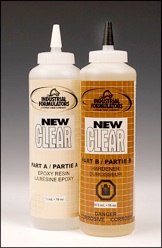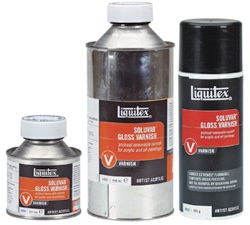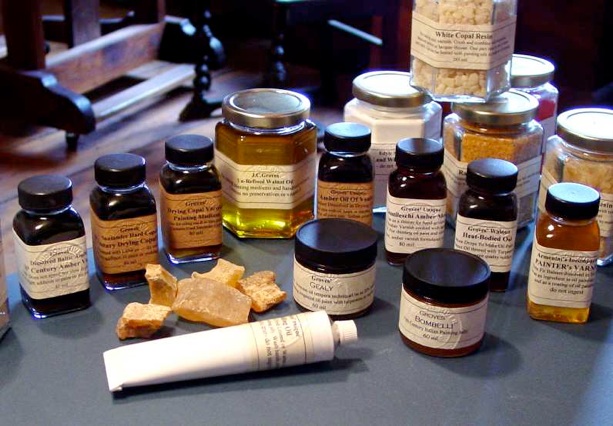Varnishes

EVERYDAY VARNISHES
Shellac Shellac is a resin secreted by the female lac bug to form a cocoon, on trees in the forests of India and Thailand. It is processed and sold as dry flakes, which are dissolved in denatured alcohol to make liquid shellac. It has many uses, including that of a high-gloss varnish.
Shellac is not recommended for use with pysanky for two reasons. FIrst, it has a warm, yellow hue, which is great on wood but not so great on pysanky. Second, it is dissolved in alcohol, which can have varying amounts of water in it. If there is too much water, it can wash off the aniline dyes from a pysanka.
Spar Varnish Spar varnish (also called marine varnish) is high quality, waterproof, and sunlight-resistant varnish named for its use on ship or boat spars and other woodwork where a glossy finish is desired. Modified tung oil and phenolic resins are often used. Better grades of spar varnish have substantially higher amounts of UV-absorbers added.
AVOID marine spar varnish–although it is UV protective, the varnish itself yellows A LOT!
Polyurethane varnish This varnish has been around for a long time, and is used by many pysanka artists. It is clear, relatively inexpensive (a small jar goes a very long way), and dries to a nice, clear satin or gloss finish overnight. Brand names include Varathane and Minwax.
A disadvantage of polyurethane varnishes is that they yellow slightly with age, and do not have UV protection. Since these varnishes were meant for wood products (furniture), the slight yellowing is considered a good thing by the makers. Different polyurethane varnishes have different degrees of yellowing; it is best to ask at your hardware store for a recommendation. These varnishes are very easy to apply: put a few drops of varnish in the palm of your hand (using a vinyl glove makes clean-up much easier), and roll the egg around until it is evenly coated. It is best to apply it lightly, to avoid drips and thick spots.
The newly varnished egg should be dried on a drying rack, either a fancy wooden one, or simply three thumbtacks pushed through a bit of cardboard (pointed ends against the egg shell). If the egg is already emptied, it can be dried by placing it on an upright skewer or thicker floral wire to dry (through the hole used for emptying).
Eggs will dry in a few hours in dry conditions (e.g. my house in winter), and make take a day or longer in humid conditions (e.g. my house in summer).
To get a nice glossy finish, apply several thin coats. Avoid layering the varnish too thickly; it will form unsightly drips as it flows to the most dependent (lowest) point during the drying process.
When buying varnish, purchase the smallest jar available, as it really lasts. Opening and closing the top of the can repeatedly dents it, breaking the seal and allowing air in. The varnish then thickens, crusts over and gets yellower, and will NOT look nice on an egg. DO NOT use thickened, yellowed varnish, unless you are applying it to a brown egg pysanka.
You can thin varnish by adding mineral spirits to it. This is merely a temporizing measure, though; if a can’s lid has gotten so dented that the varnish is thickening, it will continue to do so. It is better to buy smaller quantities and not waste varnish.
SPECIALITY VARNISHES

Some pysanka artists have begun to use epoxies as a finish for their eggs. The advantage is a strong, clear coat. Epoxies are thought to yellow less with age, but are a bit more challenging to apply. If you choose to use an epoxy, make sure that you choose one that is used for finishing, not for bonding, as the latter do yellow considerably with time. Also, select one with a fairly long cure time, minimally 20 minutes. Shorter cure times will result in the epoxy setting before you can finish applying it.
A suggested brand is Industrial Formulations.
Acrylic Acrylic varnishes are typically water-borne varnishes with the lowest refractive index (highest degree of clarity) of all finishes, although some acrylics are mineral spirit based. They impart little or no color, but sometimes lack the brushability and self-levelling qualities of solvent-based varnishes. Generally they have good UV-resistance, which helps protect artwork from fading in exposure to light.
If choosing an acrylic varnish for your pysanky, make sure to avoid water-based ones.

Because of its thin consistency, the varnish dries quickly. The instructions recommend a 3-5 day drying time (paintings), but pysanky seem to be dry to touch overnight. Give plenty of time for thorough drying between coats to avoid ending up with a tacky finish.
The final finish is shiny, but not glassy like an epoxy. The product comes in a can with an inside protective metal cap that needs to be removed. (The metal cap can be removed easily with an Exacto knife.)
Golden MSA Hard with UVLS The MSA in the name stands for Mineral Spirit Acrylic. This varnish provides a glossy, clear and UV protective finish, but has several disadvantages: availability, price and difficulty of application. It can not be sent through the mail, so must be found locally and purchased in person. The price is fairly steep. And it must be applied by dipping the entire egg and allowing the MSA to drain off and dry.
The curing process is a long one; even once the surface is dry to touch, the finish is still drying. Eggs finished with MS must be handled carefully, especially if shipping or storing. You can read more about using this varnish for pysanky here.
(Note: I have no personal experience with any of the specialty varnishes. The information provided is based on experiences of others.,)
Back to Main Finishing page
Back to Main Pysankarstvo page
Search my site with Google
Types of Varnishes



